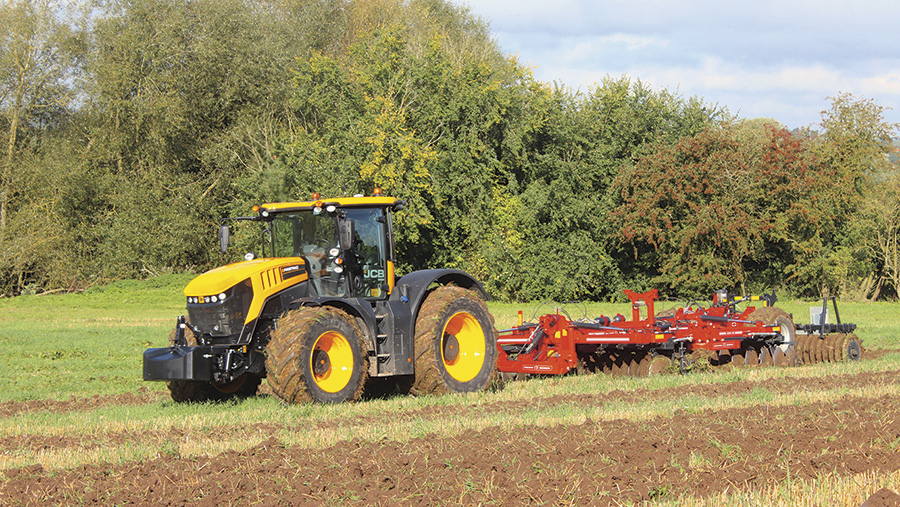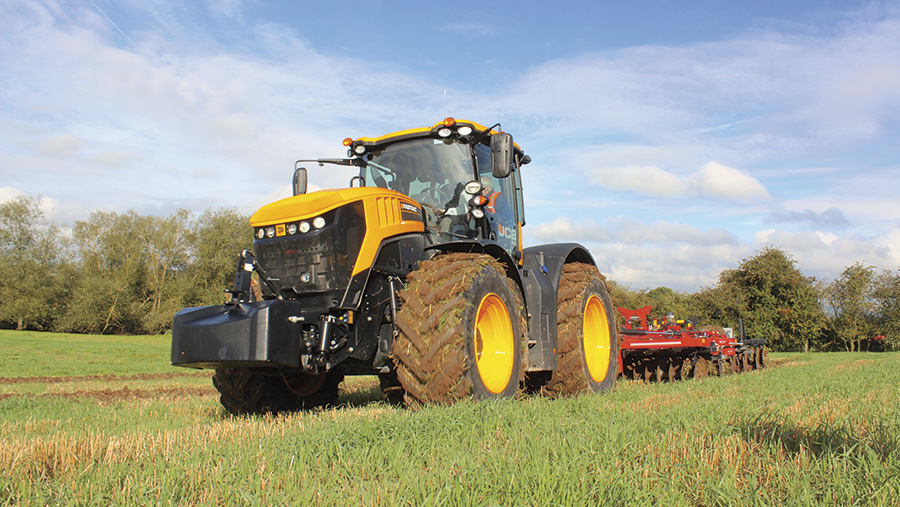New 8000-series Fastrac is JCB’s biggest ever tractor
JCB has pulled the wraps off its biggest ever Fastrac tractor, which will step into the shoes of the outgoing 8000 series when production begins later this year.
The two new models bring unprecedented power outputs to the company’s range of tractors, with the biggest 8330 singing to the tune of 335hp and the 8290 rated to 280hp.
It is a refresh rather than a revolutionary compared with previous models, with the cab and steering the most obvious subjects of JCB’s focus.

See also: JCB Fastrac 4000 tractor gets first test
Cab
The mid-mounted living space is a replica of the well-received 4000-series, which launched last year.
The driving position has been shunted forward a few inches, which frees up extra space on the rear load deck for a mounted sprayer or seed hopper.

A generous fitment of glass should improve visibility from the swivelling seat and JCB has continued with its forward-raked cab frame and vertical windscreen to maintain decent headroom for drivers.
The old power-assisted mechanical steering system has also been upgraded to a clever dual hydrostatic arrangement, which the company reckons will reduce the wrestling required to turn the wheel at slower speeds.
The new set-up includes a fail-safe system that guarantees steering power even if something goes wrong in the hydraulic or engine department.
JCB has also added a Rapid Steer option, which is becoming the norm on tractors across the board and allows drivers to trim lock-to-lock turns from four to two below 10kph.
Tractors come GPS-ready and can steer themselves, but the company is yet to update its in-cab screen.
It means Isobus enthusiasts will have to wait a little longer for complete compatibility, unless they invest in a Trimble monitor to sit alongside the standard JCB screen.
Engine
The original 8000-series was introduced in 2005 and was powered by an 8.3-litre, 250hp Cummins engine coupled to a 65kph CVT ‘box.
However, updates in 2011 saw two refreshed 8000 models make the switch to Sisu power with an 8.4-litre oil-burner tuned to 279hp in the 8280 and 306hp in the 8310.
The changes also heralded the introduction of the Fendt-sourced Vario CVT gearbox.
Drivetrains in the latest models are still sourced from Agco, but minor tweaks have increased power by 14% and torque by 10% thanks, in part, to a brace of turbochargers plumbed in series.
The two-range stepless transmission is the same as the bigger Fendt tractors and will hit a top speed of 70kph through different driving modes, including the option of using virtual steps if you prefer the driving characteristics of a powershift machine.
The suspension has also been carried over from the older models.
So while the 4000-series has self-levelling rams on all four corners, the latest 8000 relies on the old coil spring and damper arrangement at the front and hydro-pneumatic rams at the back to help compensate for rear load.
Models compared |
||
|
|
8290 |
8330 |
|
Rated power |
280hp |
335hp |
|
Max power |
306hp |
348hp |
|
Max torque |
1,310Nm |
1,440Nm |
|
Engine |
Agco Power six-cyl, 8.4-litre |
|
|
Transmission |
Two-range CVT |
|
|
Suspension |
Coil spring and damper (front), 45mm hydro-pneumatic rams (rear) |
|
|
Lift capacity |
10t rear, 3.5t front |
|
|
Hydraulics |
137 litres/min (178 litres/min option) |
|
|
pto |
Electro hydraulic two-speed rear (540e/1,000) |
|
|
Brakes |
Outboard discs with two callipers and ABS on four wheels |
|
|
Weight |
11,090kg |
|
|
Tyres |
540/65 R38 front, 710/70 R38 rear |
|
|
List price |
£176,244 |
£183,869 |
Other updates
Along with new cabs on the mid-range wheeled loaders, JCB has added an AdBlue system and extra boom damping to its TM telescopic pivot-steer handlers.
Power comes from the same 4.4-litre block, but there’s now the option of a programmable reversible cooling fan, along with extra LED lights and harder wearing bearings.
The company also unveiled a new mini loading shovel rated to 0.3cu m.
The 403 Agri is designed for pig and poultry units and is powered by a four-pot, 36hp Kubota engine driving through a two-range Rexroth-built hydrostatic drive.
A top speed of 20kph is standard, though 30kph is an option, and the ZF-sourced axles can be combined with manual diff-locks for a few extra quid.
Buyers can also spec a fully glazed cab while staying within the 2.2m tall and 1.1m wide, as well as other handy features including parallel lift, hydraulic attachment pin operation and arm extensions that take reach up to 2.8m.

